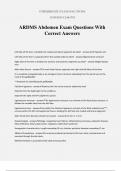©THEBRIGHT EXAM SOLUTIONS
11/05/2024 12:06 PM
ARDMS Abdomen Exam Questions With
Correct Answers
Left lobe of the liver is divided into medial and lateral segments by what? - answer✔Left hepatic vein
Left lobe of the liver is separated from the caudate lobe by what? - answer✔ligamentum venosum
Right lobe of the liver is divided into anterior and posterior segments by what? - answer✔Right hepatic
vein
Main lobar fissure - answer✔The main lobar fissure separates the right and left lobes of the liver.
It is visualized sonographically as an echogenic linear structure extending from the portal vein to the
neck of the gallbladder
**landmark for identifying the gallbladder
Falciform ligament - answer✔Attaches the liver to the anterior abdominal wall
Extends from the diaphragm to the umbilicus
Separate the right and left subphrenic spaces
Ligamentum venosum - answer✔The ligamentum venosum is a remnant of the fetal ductus venosus. It
divides the caudate lobe from the left lobe.
Ligamentum teres - answer✔Lies within the falciform ligament, remnant of the fetal umbilical vein***,
courses within the left intersegmental fissure, dividing the left lobe into medial and lateral segments
Main Portal Vein diameter should not exceed: - answer✔13 mm or 1.3 cm
Hepatomegaly - answer✔Etiology: congestive heart failure, inflammatory processes, polycystic disease,
fatty infiltration, biliary obstruction, neoplasm, budd-chiari syndrome
Sonographic characteristics: Length exceeding 18 cm, Anterior-posterior diameter exceeding 15 cm
Alkaline Phosphatase - answer✔An enzyme produced primarily by the liver, bone, and placenta and
excreted through the bile ducts
Marked elevation is associated with obstructive jaundice
, ©THEBRIGHT EXAM SOLUTIONS
11/05/2024 12:06 PM
Alpha-fetoprotein - answer✔A protein normally synthesized by the liver, yolk sack, and GI tract of the
fetus
Nonspecific marker for malignancy
Alanine Aminotransferase (ALT) - answer✔An enzyme found in large concentration in the liver and lower
concentrations in the heart, muscle, and kidneys
Remains elevated longer than AST
Elevation associated with cirrhosis, hepatitis, and biliary obstruction
Mild elevation associated with liver mets
Aspartate Aminotransferase (AST) - answer✔An enzyme present in many types of tissues that is
released when cells are damaged or injured; levels will be proportional to the amount of damage and
time between cell injury and testing
Associated with hepatitis, cirrhosis, and Mononucleosis
Prothrombin time - answer✔Normal clotting time is 10-15 seconds
enzyme produced by the liver
production depends on amount of Vitamin K
elevation associated with cirrhosis, malignancy, malabsorption of Vitamin K, and clotting failure
Decreases with subacute or acute cholecystitis, internal biliary fistula, carcinoma of the GB, injury to the
bile ducts, and prolonged extrahepatic biliary obstruction
Hepatic Candidiasis - answer✔Fungal infection
Immune-suppressed patients, Fever, chills, abdominal pain, palpable liver
Uniformly hypoechoic lesions within the liver parenchyma, thick wall margins, hepatomegaly, may
demonstrate a target or "wheel within a wheel," hyperechoic lesions with posterior shadowing
Echinococcal cyst - answer✔Parasitic infection (Echinococcus granulosum)
***Sheep farmers
RUQ pain, fever, leukocytosis, hepatomegaly, elevated alkaline phosphatase
Septated cystic mass (honeycomb appearance)
Mobile internal echoes (snowflakes)
Cyst containing small cysts (daughter cysts)
, ©THEBRIGHT EXAM SOLUTIONS
11/05/2024 12:06 PM
Hepatitis - answer✔Fatigue, loss of appetite, fever and chills, nausea, nonobstructive jaundice, marked
elevation in aspartate aminotransferase, alanine aminotransferase and bilirubin
Normal-appearing liver parenchyma
Hypoechoic liver parenchyma
Prominence of the portal veins (star effect)
Hepatomegaly
Splenomegaly
Increased echogenicity in chronic cases
Schistomiasis - answer✔Parasite entering the skin or mucosa and traveling to the lung and then liver;
symptoms may take 4-6 weeks to appear, may even take several years to develop
Rash, fever, RUQ pain, diarrhea, lymphadenopathy
Increase in echogenicity of the portal vein walls,
thick portal wall margins, atrophy of the right lobe, hypertrophy of the left lobe, thickening of the GB
wall, portosystemic collaterals
Hepatic Adenoma - answer✔Long history of oral contraceptive use
Associated with Type 1 Glycogen Storage Disease
Asymptomatic, normal labs, RUQ pain
Solid, slightly hypoechoic mass, hypoechoic halo, complex mass is demonstrated with hemorrhage or
necrosis
Cavernous hemangioma - answer✔Most common benign liver mass
Female prevalence
Benign congenital neoplasm consisting of large blood-filled cystic spaces
Asymptomatic, RUQ pain
Homogenous, hyperechoic mass
Well-defined margins
Round shape
Typically located in the Rt lobe of the liver
May increase in size




